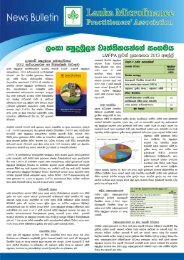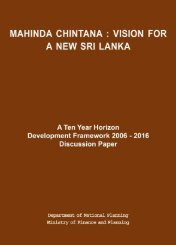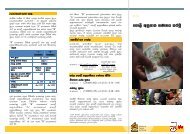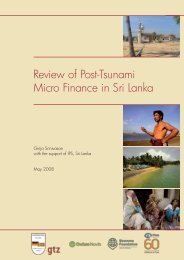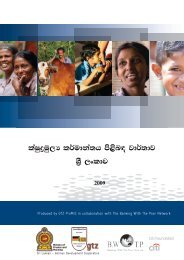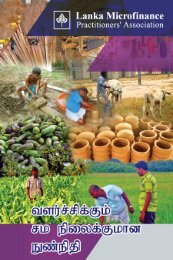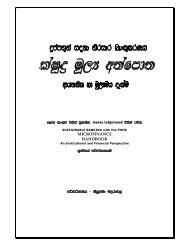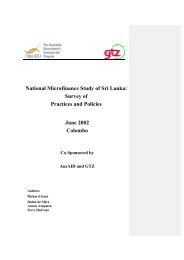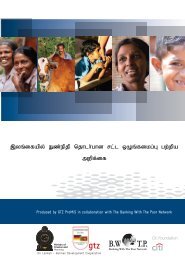M-CRIL's ratings
M-CRIL's ratings
M-CRIL's ratings
You also want an ePaper? Increase the reach of your titles
YUMPU automatically turns print PDFs into web optimized ePapers that Google loves.
Facilitating fund flows to MFIs:<br />
How financial and social <strong>ratings</strong> help<br />
Micro-Credit Ratings International Ltd<br />
Micro Credit Ratings International Ltd<br />
602 Pacific Square, 32nd Milestone NH8, Gurgaon 122001 INDIA<br />
sanjaysinha@m-cril.com Tel: +91 124 230 9497, 230 9707 Fax: +91 124 230 9520
What we will talk about<br />
• M-CRIL as a microfinance rating agency<br />
• What microfinance performance rating is about<br />
• Why social <strong>ratings</strong> were introduced<br />
• How these services facilitate the flow of funds
What is M-CRIL<br />
• World’s leading mf rating agency – 700 <strong>ratings</strong> in 30<br />
countries – spread across Asia and into Europe and Africa<br />
• A decade of pioneering experience in mf rating services<br />
• Professionally qualified team of 12 analysts.<br />
• Independent rating review committee with microfinance<br />
experts<br />
• Range of clients/partners - Multilateral, Bilateral and<br />
other Development Organisations, Not-for-profit<br />
Organisations, Govt. Organisations, FIs, MFIs and others<br />
• Record of pioneering products in microfinance analysis
M-CRIL has…<br />
• Record of pioneering products in poverty-focused<br />
programmes<br />
– One of the first to introduce financial rating of MFIs, 1998<br />
– First to introduce social rating of MFIs, 2005<br />
• rating of chit funds [formal RoSCAs], 2008<br />
– Pipeline, 2009<br />
• low cost private schools in developing countries<br />
• value chain initiatives for microenterprise promotion<br />
• community led slum redevelopment initiatives
What is rating?<br />
A standardised tool to enable investors – mainly lenders and<br />
donors – to<br />
• understand the risk profile and credit-worthiness of micro-<br />
banks/MFIs – both in absolute terms and in relation to other<br />
similar institutions<br />
• estimate the absorptive capacity of MFIs and estimate the<br />
risk associated with lending to each institution<br />
• via a Social Rating provide feedback on the MFI’s ability to<br />
achieve the impact it seeks<br />
M-CRIL’s <strong>ratings</strong> were launched specifically to facilitate the<br />
M-CRIL s <strong>ratings</strong> were launched specifically to facilitate the<br />
flow of socially responsible funds into microfinance
What microfinance rating is about<br />
Microfinance rating is the rating of MFIs (mainly) by<br />
specialist institutions<br />
Started about 11-12 years ago with <strong>ratings</strong> in Latin America<br />
and by M-CRIL in South Asia<br />
The standard performance rating consists of making a<br />
systematic assessment and benchmarking of the<br />
performance of an MFI from the perspectives p of<br />
• Governance, product delivery & competitive strategy<br />
• Management systems – portfolio tracking, MIS,<br />
internal controls, human resources<br />
• Financial performance including portfolio quality<br />
It needs a specialist knowledge of microfinance since it is<br />
It needs a specialist knowledge of microfinance since it is<br />
a diagnostic assessment of performance not just of risk
M-CRIL financial/credit rating..<br />
“..provides an objective assessment of the performance of<br />
institutions providing financial services to low income<br />
families – MFIs, NBFIs, rural and cooperative banks as<br />
well as commercial banks with a focus on mf”.<br />
• Evaluates the MFI or bank’s creditworthiness as well as<br />
its strengths and weaknesses.<br />
• Assesses the risks associated with lending to the<br />
organisation (incl. external risk, credit risk, market risk and the risk of fraud)<br />
• It covers – the quality of the governing board, the depth<br />
of management systems and financial health
Rating Instrument<br />
– areas of assessment<br />
1 Governance & strategy t (20%) – determines<br />
continuity, transparency, ability to grow & work within<br />
cost parameters, minimise risk<br />
2 Management (40%) – assesses HR policies, MIS,<br />
internal controls, tracking and follow up of overdues –<br />
overall risk management<br />
3 Financial performance (40%) – comments on the<br />
portfolio quality and current and historical<br />
i profitability/sustainability of the MFI – includes PAR,<br />
RoA as the key factors
Governance & strategy<br />
Indicators on experience and strategy:<br />
professional experience of the board members<br />
degree of focus on micro-finance<br />
degree of concentration of operations<br />
development strategy and services provided<br />
involvement in mf
Management<br />
Indicators on:<br />
quality of management and field staff members<br />
quality of accounts and MIS<br />
financial control systems and cash flow management<br />
strength and capability of borrower groups<br />
level and adequacy of infrastructure
Financial performance<br />
Indicators like:<br />
age statement of overdues and portfolio quality (>60 days)<br />
financial management<br />
liquidity and coverage<br />
capital adequacy<br />
operational efficiency<br />
return on assets and sustainability
Rating process<br />
at M-CRIL<br />
at the MFI<br />
Scheduling<br />
Start-up<br />
- discussion with head of operations<br />
- head office data collection<br />
Field visit<br />
- branch visits it & data collection<br />
- MIS verification<br />
- client interaction<br />
Follow up & de-briefing<br />
- discussion of preliminary analysis<br />
- filling data gaps
Rating process …continued<br />
at M-CRIL<br />
Data analysis<br />
& report writing<br />
Draft report to MFI<br />
- for feedback<br />
- report revision based on feedback<br />
Review by Rating Committee<br />
- MFI views presented alongside<br />
- final decision on grade & recommendation<br />
Report finalised<br />
and submitted to client
M-CRIL’s rating grades<br />
α++<br />
Highest safety, very good systems<br />
most thighly hl recommended<br />
d<br />
α+ Very high safety, good systems<br />
highly recommended<br />
α<br />
High safety, good systems<br />
highly recommended<br />
α- Reasonable safety, good systems<br />
recommended<br />
β+ Reasonable safety, reasonable systems<br />
recommended, needs monitoring<br />
β<br />
Moderate safety, moderate systems<br />
acceptable<br />
needs improvement to handle large volumes
M-CRIL’s rating grades …continued<br />
β−<br />
Significant risk, poor to moderate systems<br />
acceptable only after improvement<br />
γ+ Substantial risk, poor systems<br />
needs considerable improvement<br />
γ<br />
Highest risk, poor systems<br />
not worth considering
…the performance of MFIs<br />
Latest rating grades of 145 MFIs<br />
45<br />
40<br />
35<br />
30<br />
25<br />
20<br />
15<br />
7<br />
3 4 8<br />
32<br />
Others<br />
India<br />
10<br />
5<br />
0<br />
15<br />
17<br />
17<br />
7<br />
15<br />
10<br />
2<br />
5<br />
3<br />
γ γ+ β− β β+ α− α α+
Why social <strong>ratings</strong> were introduced<br />
Within the past few years, the performance rating has been<br />
complemented by a social rating<br />
Concerns have emerged about MFI commitment to the social<br />
values on which they are predicated<br />
Social rating was developed to assess the translation of<br />
mission into practice<br />
• Outreach to target clientele – poor/women or m-e’s<br />
• Commitment to social values – client protection,<br />
employment generation, staff working conditions<br />
• Design of products/delivery systems to meet the<br />
needs of clients
Social rating<br />
• Key areas of assessment<br />
– clarity of mission and alignment of systems<br />
– social responsibility and transparency of operations<br />
(clients, staff, society)<br />
– depth of outreach<br />
– suitability of products to serve the needs of clients<br />
• Output = a good understanding of the MFI’s ability to<br />
generate social value<br />
• Demand for social <strong>ratings</strong> is increasing but not yet as<br />
widespread as for credit rating – about 50 undertaken
Impact of rating on the growth of mf<br />
• Availability of a standard assessment system has drawn<br />
in commercial banks as well as development elopment banks and<br />
donors<br />
• Most private investment and international debt funds are<br />
able to function because due diligence is predominantly<br />
addressed by microfinance <strong>ratings</strong><br />
• A couple of years ago there was estimated to be some $2<br />
billion invested in microfinance and another $5 billion<br />
available for such investment<br />
• In India alone the coverage of microfinance clients by MFIs<br />
has jumped from around 0.5 million clients 12 years ago to<br />
around 20 million clients now<br />
• Much of this is attributable to the availability of financial<br />
resources
M-CRIL’s <strong>ratings</strong> were launched…<br />
…specifically to facilitate<br />
the flow of commercial funds into<br />
microfinance<br />
this may now be reinterpreted as<br />
the flow of socially responsible funds into<br />
the flow of socially responsible funds into<br />
double/triple bottom line programmes






